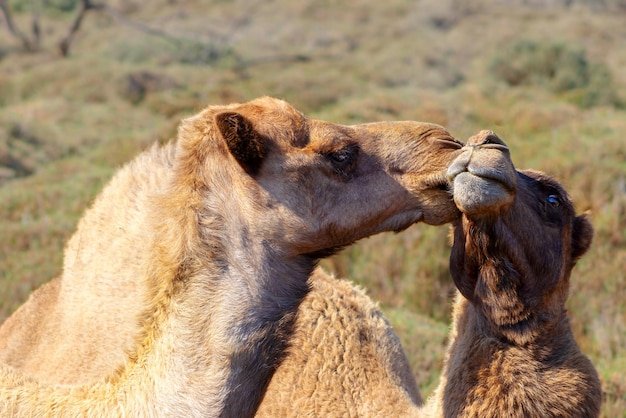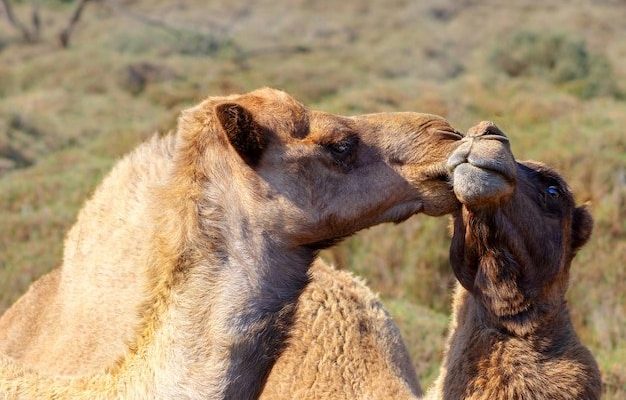
Imagine being stranded on an island all alone. Wouldn’t you crave the company of someone else? Camels can feel something similar. They are social animals that tend to thrive in groups, known as herds. But let’s dive deeper into their social habits and see what this means for camels and their companions.
Are Camels Naturally Social Animals?
Honestly, camels are inherently social. In the wild, they often travel in herds, sticking together for protection and companionship. Like many herd animals, they rely on one another to help identify threats, find food, and even keep warm during cold nights.
Male camels, or bulls, may seem a bit more solitary during mating season, but outside of that time, they prefer to be part of the crowd. Meanwhile, females and their young often form strong bonds within the herd. Have you ever seen parents and their kids interact at a family reunion? There’s a similar dynamic in camel herds, where they care for each other and raise their young collectively.
So, if you’re thinking about keeping a camel, consider that they may not do well alone. They thrive when they have a companion—either another camel or even another type of animal that they can bond with.
The Importance of Companionship
You might be wondering why companionship is such a big deal for camels. Just like us, they need social interactions for emotional and mental well-being. Camels can become stressed if they’re isolated. This stress can lead to health issues, just as feeling lonely can impact our mood or even cause physical ailments.
Imagine trying to tackle a big project all by yourself. It’s a lot easier when you have someone to bounce ideas off of, right? Camels feel the same way. Having companions can help them navigate challenges and adapt to new environments. This is particularly important if they’re being raised in domestic settings where their natural herd dynamics aren’t available.
Moreover, camels have a rich emotional life. Their ability to form strong bonds can lead to inseparable friendships, which helps them feel secure and content. So, whether it’s a fellow camel or even a different animal, having a buddy is beneficial for their overall happiness.
What Happens When Camels Are Alone?
When a camel doesn’t have a companion, it can lead to some less-than-ideal scenarios. Picture a dog left alone at home—it might bark, whine, or even chew on things it shouldn’t. Camels can react similarly. They might show signs of distress, like pacing or vocalizing more than usual.
If you’re ever in a situation where a camel is left without a herd, you might notice changes in their behavior. They could become more withdrawn or even aggressive out of frustration. Think of it like trying to have a good time at a party when all your friends are absent—it’s just no fun!
In fact, studies have shown that animals kept alone may develop issues like stereotypic behaviors, which are repetitive actions often caused by stress. This could include over-grooming or pacing. Not only does this indicate discomfort, but it can also seriously affect their quality of life.
Keeping Camels Happy: Choosing the Right Companion
When selecting a companion for your camel, there are a few things to keep in mind. First, consider compatibility. Not all animals get along, so it’s essential to find a companion that’s both physically and socially compatible.
– Another Camel: The best option is, of course, another camel. They understand each other’s behaviors and needs, making them ideal companions.
– Other Animals: If a second camel isn’t an option, some owners have successfully introduced goats, sheep, or even donkeys as companions. Just ensure the animals can interact safely.
– Human Interaction: While humans can’t replace a camel’s need for another camel, spending time with them can help alleviate some loneliness. Regular interaction is key.
Additionally, introducing a new companion should be done gradually. This process is similar to how you might introduce a new friend to your circle—take it slow and allow them to get comfortable with each other.
Understanding Camel Communication
Camels, like many animals, have their own way of communicating. From body language to sounds, understanding these signals can help you gauge their social needs. Camels can express a range of emotions—happiness, anxiety, and even anger.
– Vocalizations: They grunt, bellow, or even hum to communicate with each other. These sounds help maintain connections within the herd.
– Body Language: A camel might lean against another to show affection or comfort. Similarly, a stiff posture can indicate stress or discomfort, which is crucial to watch for.
– Grooming: Just like good friends share a laugh or a hug, camels groom one another to strengthen bonds. If you see them rubbing their necks together, it’s a sign of camaraderie.
By paying attention to these cues, you can better understand your camel’s emotional state and provide the companionship they crave.
In summary, camels are social beings that thrive in the company of others. They naturally seek companionship, whether it’s from another camel or even a different animal. Neglecting their social needs can lead to stress and behavioral issues, affecting their overall well-being.
So, if you’re considering bringing a camel into your life, keep in mind their need for companionship. Understanding their social habits and providing supportive interactions can dramatically improve their happiness and health. Remember, a happy camel is not just a joy to be around—it’s also a sign of a well-cared-for animal. Let’s ensure our camel friends have the companionship they deserve!

